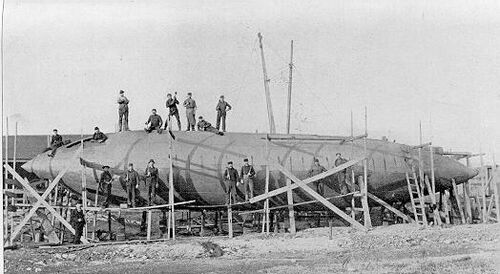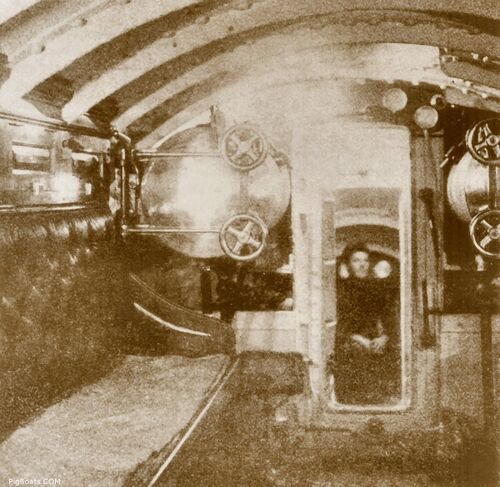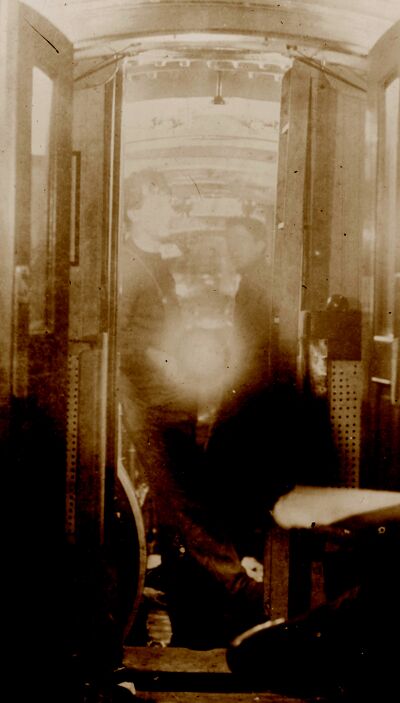Protector1: Difference between revisions
Pbcjohnston (talk | contribs) Added header |
Pbcjohnston (talk | contribs) Added photos and captions |
||
| Line 1: | Line 1: | ||
[[File:Header 4 New.jpg]] | [[File:Header 4 New.jpg]] | ||
[[File:Protector construction 1.jpg|left|500px]] | |||
<div style="text-align: justify;"><span style="color:#00008B">Protector under construction at the Lake facility at Bridgeport, CT. January 1902. Note the man standing in the torpedo tube door opening. After construction of the hull Lake built a superstructure to provide a walking deck and sea keeping abilities to the vessel (see below). | |||
<small>Photo in the private collection of Ric Hedman.</small> | |||
[[File:Red bar sub new.jpg]] | |||
[[File:Protector construction 2.jpg|left|500px]] | |||
This photo was taken on February 20, 1902 and shows a progression in construction of Protector. You can see the framework for the superstructure being assembled. Two of the superstructure plates are in place. Notice the reverse bow that was becoming a signature of ship design in the last decade of the 19th century and early 20th century. Lake placed his 10 foot long and 14 inch wide hydroplanes within this superstructure. One set just forward of midships and one set just aft of midships. These enabled Lake's well-publicized zero-angle diving method, which he felt was safer than the angled dive of the Electric Boat submarines. The first section of the conning tower has been put in place atop the boat. | |||
<small>Photo in the private collection of Ric Hedman.</small> | |||
[[File:Red bar sub new.jpg]] | |||
[[File:Protector-fwd.jpg|left|500px]] | [[File:Protector-fwd.jpg|left|500px]] | ||
A January, 1904 photo of the Protector's interior. This view is looking forward towards the bow. It can be seen that the torpedo tube inner doors are actually in the compartment with the bench seats. Spare torpedoes are being kept under the bench seats, although that would limit the number of torpedoes that could be carried. The watertight door leads into the diving compartment, and a crewman can be seen sitting in there. | |||
<small>Library of Congress photo.</small> | <small>Library of Congress photo.</small> | ||
| Line 9: | Line 23: | ||
[[File:Protector-interior.jpg|left|500px]] | [[File:Protector-interior.jpg|left|500px]] | ||
This view inside Protector is looking aft from the area of the torpedo tube breech doors. It is quite possible that the man lying on the settee sleeping is Simon Lake. He appears to be older and has a mustache. This posed photo was meant to emphasize the level of "comfort" that Lake had built into boat. It has the look of a Pullman railroad car. The view is looking aft and through the pantry where food could be prepared into the engine room, where two men are looking at the camera. The area could be closed off from the forward compartment by two swinging doors with glass windows. These are non-watertight doors and were mostly intended for isolation of noise and fumes from the engine room. | |||
<small>Library of Congress photo.</small> | |||
[[File:Red bar sub new.jpg]] | [[File:Red bar sub new.jpg]] | ||
[[File:Lake calendar.jpg|left|500px]] | |||
This is a closeup of the photo above and shows a calendar hanging on the bulkhead that gives the date. In February 1904 the Protector was sold to the Russian Navy at the outbreak of the Russo-Japanese War. The calendar above his head firmly dates this photo to January or early February 1904 before the Protector was sold to Imperial Russia as the "Osetr". Lake spent the next seven years in Europe designing submarines for the Austro-Hungarian Navy, the Kaiserliche Marine, and Imperial Russian Navy. | |||
<small>Library of Congress photo.</small> | |||
[[File:Red bar sub new.jpg]] | [[File:Red bar sub new.jpg]] | ||
[[File:Protector looking aft to engine room.jpg|left|400px]] | |||
Another closeup of the aft looking photo above, showing details of the pantry and engine room. Just visible on the right aft of the small pantry is a ladder leading up to the conning tower (see diagram below). | |||
<small>Library of Congress photo.</small> | |||
[[File:Red bar sub new.jpg]] | |||
[[File:protector drawing-2.jpg|left|500px]] | [[File:protector drawing-2.jpg|left|500px]] | ||
This contemporary drawing of Protector gives a good view of the boat's interior arrangement. There was no traditional control room that had become the standard on the Electric Boat units. Instead, all control functions were centered in the conning tower, which was made of brass. The conning tower also had a viewing station for the boat's "omniscope", Simon Lake's design for a primitive periscope. It was a fixed height instrument that did not rotate. Instead, the user could rotate the prism set inside the unit to alter the field of view. | |||
<small>Library of Congress image/The Logan Republican (Logan, Utah)</small> | |||
[[File:Red bar sub new.jpg]] | [[File:Red bar sub new.jpg]] | ||
Revision as of 15:16, 22 October 2023

Photo in the private collection of Ric Hedman.

This photo was taken on February 20, 1902 and shows a progression in construction of Protector. You can see the framework for the superstructure being assembled. Two of the superstructure plates are in place. Notice the reverse bow that was becoming a signature of ship design in the last decade of the 19th century and early 20th century. Lake placed his 10 foot long and 14 inch wide hydroplanes within this superstructure. One set just forward of midships and one set just aft of midships. These enabled Lake's well-publicized zero-angle diving method, which he felt was safer than the angled dive of the Electric Boat submarines. The first section of the conning tower has been put in place atop the boat.
Photo in the private collection of Ric Hedman.

A January, 1904 photo of the Protector's interior. This view is looking forward towards the bow. It can be seen that the torpedo tube inner doors are actually in the compartment with the bench seats. Spare torpedoes are being kept under the bench seats, although that would limit the number of torpedoes that could be carried. The watertight door leads into the diving compartment, and a crewman can be seen sitting in there.
Library of Congress photo.

This view inside Protector is looking aft from the area of the torpedo tube breech doors. It is quite possible that the man lying on the settee sleeping is Simon Lake. He appears to be older and has a mustache. This posed photo was meant to emphasize the level of "comfort" that Lake had built into boat. It has the look of a Pullman railroad car. The view is looking aft and through the pantry where food could be prepared into the engine room, where two men are looking at the camera. The area could be closed off from the forward compartment by two swinging doors with glass windows. These are non-watertight doors and were mostly intended for isolation of noise and fumes from the engine room.
Library of Congress photo.

This is a closeup of the photo above and shows a calendar hanging on the bulkhead that gives the date. In February 1904 the Protector was sold to the Russian Navy at the outbreak of the Russo-Japanese War. The calendar above his head firmly dates this photo to January or early February 1904 before the Protector was sold to Imperial Russia as the "Osetr". Lake spent the next seven years in Europe designing submarines for the Austro-Hungarian Navy, the Kaiserliche Marine, and Imperial Russian Navy.
Library of Congress photo.

Another closeup of the aft looking photo above, showing details of the pantry and engine room. Just visible on the right aft of the small pantry is a ladder leading up to the conning tower (see diagram below).
Library of Congress photo.

This contemporary drawing of Protector gives a good view of the boat's interior arrangement. There was no traditional control room that had become the standard on the Electric Boat units. Instead, all control functions were centered in the conning tower, which was made of brass. The conning tower also had a viewing station for the boat's "omniscope", Simon Lake's design for a primitive periscope. It was a fixed height instrument that did not rotate. Instead, the user could rotate the prism set inside the unit to alter the field of view.
Library of Congress image/The Logan Republican (Logan, Utah)
Page created by:
Ric Hedman & David Johnston
1999 - 2023 - PigBoats.COM©
Mountlake Terrace, WA, Norfolk, VA
webmaster at pigboats dot com
